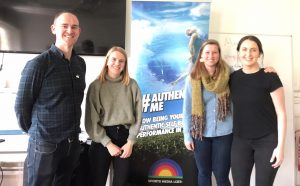Sports Media LGBT+ Challenging Perceptions Within Sports Journalism

Diversity has become a buzz word in the media. Most would agree that it’s something we desperately need more of- people on our screens and airwaves or writing in our newspapers who truly reflect our society.
Contrary to what major media organisations would have us believe, sports journalism is currently not reflecting the population at large. Striving for greater representation, communication and understanding for the LGBT+ community in sport is Sport Media LGBT+ and their founder Jon Holmes.
The organisation aims to promote inclusion in sport, working with athletes, journalists, clubs and media organisations to offer advice on how they can best represent and support the LGBT+ community in all areas of sport, including publishing their ‘Rainbow Ready’ guidebook for the media.
The help Sports Media LGBT+ provides has also been vital to many athletes sharing their stories as Jon explains.
“The one thing we hear all the time is people saying ‘I’m worried about getting it wrong. I’ve seen other people say things and get called out for it and I don’t want to be like that’.
“If we can help them, then it will be worth it,” adds Jon.
The ability to aid members of the LGBT+ community in sharing their stories comes from a place of absolute trust.
Athletes who seek out the help of Sports Media LGBT+ know that with the organisation’s help, they are best positioned to control the narrative of their life story.
“It’s so important to have that level of trust and to feel like you can ask a question in a respectful way if someone has provided that opportunity. There’re still some people who don’t know how to navigate this properly.
“I think it’s just trying to be respectful and make sure you’re asking a question and getting clarification when you need it and if you can’t get that clarification then just hold off until you’re ready,” says Jon.
Treating stories about sexuality or identity with respect and sensitivity is the gold standard, but Jon is also aware that not all athletes are treated as such, such as cricketer Maxine Blythin, who was outed as transgender last August.
“That’s probably one of the things we need to try and help, to create a culture where people don’t feel like they’re fighting against something before they’ve even reached that level of comfort in themselves,” says Jon.
“[Maxine] had to go through a period of months where she didn’t want to talk to [the media] because she had a terrible experience, but eventually she got to a point where she felt able to do that and obviously we’re really grateful that she approached us to help get her story out there.
“It was the first time she had spoken to the media in her own voice, telling her story, without somebody speaking on her behalf or misrepresenting her. Any LGBT+ athlete can take ownership of their own narrative, I think that’s hugely important for them as an individual but also for others,” he adds.
As the visibility of LGBT+ people in sport improves, LGBT+ athletes often find themselves expected to become gatekeepers, acting as a voice for the community, which may initially be a deterring factor for people coming out.
“If you’re the first in a particular sport, like a trailblazer in some respects, there’s going to be a level of responsibility, to make sure you’re not misrepresenting your community, but people are going to have to be true to themselves and you can’t be the flag waver for an entire group of people, so it’s a difficult thing to navigate,” says Jon.
While the visibility of LGBT+ people in sport is often focused on top-level athletes, Jon believes that the cultural change is much more evident at a grass-root level, where young people no longer feel sexuality is something they need to hide.
“We have some out elite athletes and they’re doing great things. They’ll share stories and have a huge impact off the back of that, but in lots of sports and lots of different parts of the LGBT+ community, it’s actually grassroots athletes that are providing that representation.
“Their stories are sometimes as fascinating, complex and different as you might find at an elite level,” says Jon.
Although such progress has been made regarding inclusion and the LGBT+ community, Jon knows that there will always be some people who will remain opposed to LGBT+ people, but we must progress in spite of this.
“You just have to be out there, on the front foot, willing to have that conversation, willing to make people think differently, give them some great examples about how their perceptions, stereotypes and assumptions about people who are LGBT+ are not what they think they are.”
You can read more about Sports Media LGBT+ ‘Rainbow Ready’ resource here where you can also download the guide.